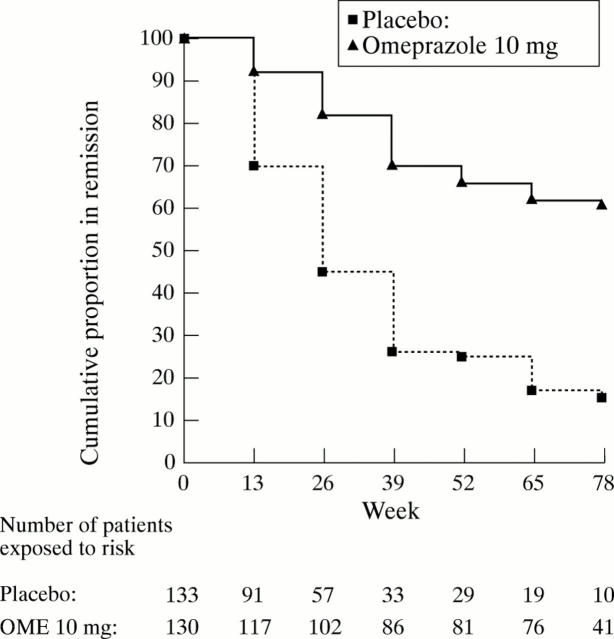Abstract
Aims—To investigate the efficacy of daily maintenance treatment with omeprazole 10 mg in reducing the relapse rate of healed erosive oesophagitis. Methods—Three hundred patients with erosive oesophagitis (grade 2 or greater) received omeprazole 20 mg daily for 12 weeks, followed by 40 mg daily for a further 12 weeks if required. After healing, patients were randomised to double blind treatment with omeprazole 10 mg daily or placebo for up to 18 months. On relapse the treatment cycle was repeated. Results—The cumulative healing rate at 12 weeks in the initial healing period was 95%, and 96% and 98% on rehealing courses after relapse in the first and second maintenance periods respectively. After 12 weeks of treatment, 98% of patients were free from heartburn and 97% were free of all reflux related symptoms. Relapse in the subgroup of patients who relapsed in both maintenance periods was infrequent on omeprazole 20 mg daily: only 9% at two years. Gastrin concentrations rose above normal in one third of patients. One patient had linear hyperplasia of endocrine cells and another had micronodular hyperplasia. There were no side effects definitely attributable to omeprazole. Conclusion—Maintenance treatment with omeprazole 10 mg daily keeps about 60% of patients with erosive oesophagitis in prolonged remission. Patients relapsing once are likely to do so again; they can subsequently be treated effectively with omeprazole 20mg daily.
Keywords: erosive oesophagitis; long term maintenance treatment; omeprazole
Full Text
The Full Text of this article is available as a PDF (121.7 KB).
Figure 1 .
Flow chart of study design showing numbers of patients in the different phases, and the principal outcomes. OME, omeprazole.
Figure 2 .
Proportions of patients continuing in remission on omeprazole (OME) 10 mg (n=130) and placebo (n=133) in the first maintenance course.
Figure 3 .
Proportions of patients continuing in remission on omeprazole (OME) 10 mg (n=28) and placebo (n=88) in the second maintenance course.
Selected References
These references are in PubMed. This may not be the complete list of references from this article.
- Bate C. M., Booth S. N., Crowe J. P., Mountford R. A., Keeling P. W., Hepworth-Jones B., Taylor M. D., Richardson P. D. Omeprazole 10 mg or 20 mg once daily in the prevention of recurrence of reflux oesophagitis. Solo Investigator Group. Gut. 1995 Apr;36(4):492–498. doi: 10.1136/gut.36.4.492. [DOI] [PMC free article] [PubMed] [Google Scholar]
- Carlsson R., Galmiche J. P., Dent J., Lundell L., Frison L. Prognostic factors influencing relapse of oesophagitis during maintenance therapy with antisecretory drugs: a meta-analysis of long-term omeprazole trials. Aliment Pharmacol Ther. 1997 Jun;11(3):473–482. doi: 10.1046/j.1365-2036.1997.00167.x. [DOI] [PubMed] [Google Scholar]
- Facer P., Bishop A. E., Lloyd R. V., Wilson B. S., Hennessy R. J., Polak J. M. Chromogranin: a newly recognized marker for endocrine cells of the human gastrointestinal tract. Gastroenterology. 1985 Dec;89(6):1366–1373. doi: 10.1016/0016-5085(85)90657-2. [DOI] [PubMed] [Google Scholar]
- Grimelius L. A silver nitrate stain for alpha-2 cells in human pancreatic islets. Acta Soc Med Ups. 1968;73(5-6):243–270. [PubMed] [Google Scholar]
- Hallerbäck B., Unge P., Carling L., Edwin B., Glise H., Havu N., Lyrenäs E., Lundberg K. Omeprazole or ranitidine in long-term treatment of reflux esophagitis. The Scandinavian Clinics for United Research Group. Gastroenterology. 1994 Nov;107(5):1305–1311. doi: 10.1016/0016-5085(94)90531-2. [DOI] [PubMed] [Google Scholar]
- Hemery P., Galmiche J. P., Roze C., Isal J. P., Bruley des Varannes S., Lavignolle A., Le Bodic L. Low dose omeprazole effects on gastric acid secretion in normal man. Gastroenterol Clin Biol. 1987 Feb;11(2):148–153. [PubMed] [Google Scholar]
- Howden C. W., Derodra J. K., Burget D. W., Hunt R. H. Effects of low dose omeprazole on gastric secretion and plasma gastrin in patients with healed duodenal ulcer. Hepatogastroenterology. 1986 Dec;33(6):267–270. [PubMed] [Google Scholar]
- Lamberts R., Creutzfeldt W., Strüber H. G., Brunner G., Solcia E. Long-term omeprazole therapy in peptic ulcer disease: gastrin, endocrine cell growth, and gastritis. Gastroenterology. 1993 May;104(5):1356–1370. doi: 10.1016/0016-5085(93)90344-c. [DOI] [PubMed] [Google Scholar]
- Laursen L. S., Havelund T., Bondesen S., Hansen J., Sanchez G., Sebelin E., Fenger C., Lauritsen K. Omeprazole in the long-term treatment of gastro-oesophageal reflux disease. A double-blind randomized dose-finding study. Scand J Gastroenterol. 1995 Sep;30(9):839–846. doi: 10.3109/00365529509101589. [DOI] [PubMed] [Google Scholar]
- Lundell L., Backman L., Ekström P., Enander L. K., Falkmer S., Fausa O., Grimelius L., Havu N., Lind T., Lönroth H. Prevention of relapse of reflux esophagitis after endoscopic healing: the efficacy and safety of omeprazole compared with ranitidine. Scand J Gastroenterol. 1991 Mar;26(3):248–256. doi: 10.3109/00365529109025038. [DOI] [PubMed] [Google Scholar]
- Maratka Z. Terminology, definitions and diagnostic criteria in digestive endoscopy. With the collaboration of the members of the Terminology Committee of the World Society of Digestive Endoscopy/OMED. Scand J Gastroenterol Suppl. 1984;103:1–74. [PubMed] [Google Scholar]
- McLauchlan G., Crean G. P., McColl K. E. Effect of low-dose omeprazole on gastric acid secretion in duodenal ulcer patients. Aliment Pharmacol Ther. 1988 Jun;2(3):263–268. doi: 10.1111/j.1365-2036.1988.tb00696.x. [DOI] [PubMed] [Google Scholar]
- Naesdal J., Bodemar G., Walan A. Effect of omeprazole, a substituted benzimidazole, on 24-h intragastric acidity in patients with peptic ulcer disease. Scand J Gastroenterol. 1984 Oct;19(7):916–922. [PubMed] [Google Scholar]
- SEVIER A. C., MUNGER B. L. TECHNICAL NOTE: A SILVER METHOD FOR PARAFFIN SECTIONS OF NEURAL TISSUE. J Neuropathol Exp Neurol. 1965 Jan;24:130–135. doi: 10.1097/00005072-196501000-00012. [DOI] [PubMed] [Google Scholar]
- Sandmark S., Carlsson R., Fausa O., Lundell L. Omeprazole or ranitidine in the treatment of reflux esophagitis. Results of a double-blind, randomized, Scandinavian multicenter study. Scand J Gastroenterol. 1988 Jun;23(5):625–632. doi: 10.3109/00365528809093923. [DOI] [PubMed] [Google Scholar]
- Sharma B. K., Walt R. P., Pounder R. E., Gomes M. D., Wood E. C., Logan L. H. Optimal dose of oral omeprazole for maximal 24 hour decrease of intragastric acidity. Gut. 1984 Sep;25(9):957–964. doi: 10.1136/gut.25.9.957. [DOI] [PMC free article] [PubMed] [Google Scholar]
- Solcia E., Bordi C., Creutzfeldt W., Dayal Y., Dayan A. D., Falkmer S., Grimelius L., Havu N. Histopathological classification of nonantral gastric endocrine growths in man. Digestion. 1988;41(4):185–200. doi: 10.1159/000199786. [DOI] [PubMed] [Google Scholar]





